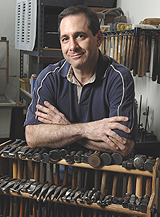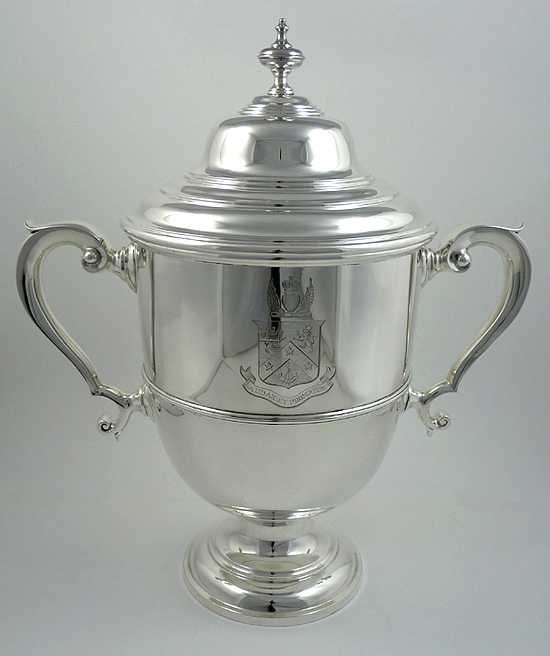
The Modern Butlers’ Journal volume 8, issue 6
International Institute of Modern Butlers
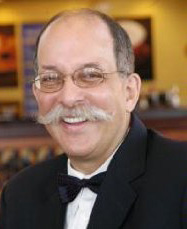 Message from the Chairman
Message from the Chairman
I am afraid that the general message being promoted about our profession by the media right now is not the best.
Firstly, a book has just been published entitled, (groan) The Butler Did It. I will not provide a link to it because it is basically tabloidal in nature. It may or may not be the truth, but some people have a habit of focusing on the salacious truths of life, to which rather too many others pay attention (while the majority of the profession, going about its business industriously and earnestly, receives scant attention).
The gist of the book, as I understand it, is that a member of the British Royal Family was one among several notables of the time involved in homosexual relationships with the butler, who also, it is said, happened to have murdered five people. This man was never trained as a butler, but brought into the profession it seems, as a sex toy.
There is no disputing the attraction of sexual sensations and uninhibited behaviour, but the Roman Empire went the same way and look where they are now. I make this historical analogy because, while we may well respect the wealthy, and particularly the royalty, we serve as professionals, we should neither hold them in awe nor allow our respect to be alloyed by the behaviour of some among them. They are but human, flesh and blood, and while their positions, gained either by industry or inheritance, have their privileges, they also have their duties, the execution of which may not always be easy.
My point? If some amongst the British Royal family have misbehaved (or still may do), this neither makes less of the standards they, and those who have served them, have worked to achieve over the last millennium; and we should not allow books such as The Butler Did It to undermine our perception of, and dedication to, those standards.
Secondly, the Pope’s butler has allegedly been busy poking through his employer’s (organizational) papers and leaking them to the press. From the reports surfacing as the investigation continues, it seems he was spying on behalf of others in an effort to help his employer, as in the case of the French butler recently taken to court for recording his employer’s conversations.
As soon as butlers start to spy on their employers, they are not being butlers but spies. It is that simple. Butlers do not have anything about “spying on my employer” in their job description, no matter how well intended. Butlers are not vigilantes. In the final analysis, the Pope has been “particularly hurt by his butler, to whom he was close, whom he knew, loved and respected.”
The message? It’s time those already in our profession, and those coming into it, re-assert our standards in the public eye so that the vast majority of employers continue to have faith in our profession, and do not come to believe that all butlers are suspect. This was the take that Giovanni Lodigianni, our man (butler) in Italy, had on the situation, too. His words: “I wrote to the Italian Butlers’ Association asking for some action be taken against the supposed butler if he is sentenced for theft, as this news is creating a huge damage to the profession at a time when work is completely lacking and we do not need a reputation of this kind.”
If you have any ideas how we, the vast majority of ethical butlers, can promote our standards, over and above the very welcome but fictional Downton Abbey, then please forward your ideas so we can share them with other members of our community.
Letters to the Editor
In answer to last month’s reader question about funeral etiquette: “There is no standard for sending a personal card or other written form of correspondence over and above the signing of a Guest Book for a Funeral. Sending an individual communication is at the discretion of the individual and normally would come from either a close family member or personal friend.” R.B.A.
****
In response to Ms. Galbari’s response to a letter from an unappreciated butler: “Very interesting letter about the butler living with a very unreasonable principal. I know how difficult this kind of situation is—I am living it. I have looked inward to find a solution and Ms. Galbari’s response/comments while wise…well, sometimes you have to pull the plug on such ridiculousness. I am hopeful I can stay through to experience my two-year mark, however, three people have quit in the last six months (which validates my persistence as well as perceptions). I keep my head down and hope for the best, as I, too, am worried about my next employer’s reaction to my leaving too soon. Very good letter …it gives me hope. Thank you very much!” R.L.
Ed: In regards to that unappreciated butler, the sequel to the story is that he is just today on the market again, having left that less-than-ideal position. As a note to other butlers who find themselves on the market, the writing of a compelling resume/CV is an art that needs to be mastered. It can be difficult, when one has a varied career, to present a clear picture of why one is the right choice as someone’s butler.
The trick is to look at the resume from the perspective or through the eyes of the potential employer, to see what he would think: what questions he might have, what he might be looking for. The goal is not to write a complete life history of you as an individual, but to focus on presenting those things that the potential employer is looking for. So yes, you may have worked as an ESL (English as a Second Language) teacher in Bophupetswana at some stage of your life, and doing so again may seem like a comfortable change from being unappreciated as a butler, but if you are serious about finding a job as a butler, do not make the objective of your job search “To find a position as an ESL teacher in Botswana or similar.” Take away lesson? If you want a job as a butler, then make the resume butler-centric. Not to say you hide information, but in any performance there is the lead actor, and there is the chorus in the background or even off-stage. Your trick is to direct the attention of the potential client to the facts that would most compel him to ask for an interview. What is the lead actor in your career track that would enthrall the audience?
***
I would love to hear from your readers on any bath rituals they have observed or practiced, and which they would most recommend. What kinds of oils, soaps, candles, music, rituals? What helpful tips? What bathroom decor ideas? TC
Ed: Good idea, thank you—please write to the editor with your ideas for publication in the next MBJ
Butlers in the Media
Another resort gets it on providing butler service to their top-end guests.
Another story about poor treatment of loyal household staff. “All I wanted was to be treated fairly, with respect and dignity. During this period of time, the majority of employees at Buckhurst Park have left,” the employee has stated.
As a profession, we really need to offer workshops for employers, just as much as their staff. In this case, the employer was educated as an architect before she came into wealth by marriage and was expected to understand human nature and the proper management of employees so as to bring out the best on them. This is not necessarily an innate skill nor something offered on the syllabus of architecture courses. The employer is as much a victim as the employee.
One of the Institute’s members in the news, receiving an award—congratulations.
The Pope’s butler commits the cardinal sin.
Placement
A luxury resort in the Maldives is looking for an Assistant Head Butler to help manage the forty butlers. 25K per annum, etc., no taxes. For more details, ask.
Cigars, Part IV
Handmade Cigars
Before the matured tobacco can be rolled into cigars, the spine of the leaf must be removed with a small blade worn on the thumb, splitting the leaf in two. The leaves are suspended in bunches or stacked in neat piles called ‘books’ and processed together using a treadle-operated guillotine. From this point on, when we talk about ‘leaves’ we are actually talking about leaf halves.
Hand rolling a cigar is a difficult art to master, especially the complicated shapes of the figurados. The cigar roller, known as a ‘torcedor,’ needs just a few tools: chief among these is a broad, flat blade called a chaveta that is similar to one used in a kitchen to chop herbs, but without the handles on either side; he also uses a platform, which serves as both a working surface and chopping board; and vegetable glue called pectin. Finally, cigar molds that are provided by the factory.
A handmade cigar consists of three parts; the filler, the binder and the outer leaf known as the wrapper. The torcedor begins by preparing the filler. The number of leaf-halves used will depend on the size of the cigar. These leaves may be from the same source, or may be a blend of different tobaccos to give a more complex flavour.
The leaves must be rolled carefully if the cigar is to draw and burn properly. One method involves stacking the leaves before rolling. Another method, said to originate in Cuba, is called ‘entubar’. In this method, each leaf is carefully folded before the filler is bunched together. The aim in each case is a balanced construction resulting in an even burn and a light draw.
The next leaf is the binder, coarser in appearance than the wrapper and a very important part of the cigar’s construction: not only does it hold the filler together, determining the final shape and size of the cigar, it must also provide an even surface for the wrapper, free of bumps or hollows. Once the binder is on, the unfinished cigar is placed in a cedarwood mold to rest for 30 – 45 minutes. The mold fully encloses the cigar, except for the foot (the end you light). This may protrude slightly and is trimmed flush with the side of the mold, so that all the cigars will be exactly the same length.
While the cigars are in the mold, the torcedor clears the platform and prepares the wrappers. These are the most expensive leaves, chosen with great care. As they will determine the final appearance of the cigar, they should not have any blemishes or tears. The torcedor selects the best part of the leaf and trims it into the correct shape to wrap the cigar. Unlike the binder which is placed over the filler longitudinally, the wrapper will be wound around the cigar in a spiral. Pectin is applied to the wrapper and the cigar removed from the mold and wrapped. This is said to be the most difficult part of cigar making. In factories where rollers work in teams, the task of wrapping the cigars is entrusted to the more experienced torcedors.
The next step is adding the cap, a circular piece of leaf which finishes off the head of the cigar and secures the wrapper leaf in place. This small disc of tobacco is most often cut out with a punch, though I have heard of torcedors cutting around a coin. From here, the cigar will go for inspection and final sorting before being boxed.
If the cigar is to have a band, it is added before the cigar is boxed: the cigar is placed on a wooden form with a mark indicating where the band is to be positioned so they form a neat line in the box. The band is affixed with the same pectin used to apply the wrapper. This is why it is important not to remove the band before smoking the cigar—doing so may tear the wrapper.
Let’s Talk about Wine, Part VI
 by Amer Vargas
by Amer Vargas
Champagne, Part III
Before inserting the cork onto a champagne bottle, vintners add what is called “licquéur d’expédition,” which is a bit of base wine (the product obtained after the first fermentation) plus a certain amount of sugar. The amount of sugar will determine the level of sweetness of the final product, always mentioned on the label as ‘doux’ (sweet) and then, in increasing dryness, ‘demi-sec’ (semi-dry), ‘sec’ (dry), ‘extra sec’ (extra dry), ‘brut’ (very dry), ‘extra brut’ (a bit drier than brut), and ‘brut nature’ (no additional sugar, bone dry).
Although it may not seem so, the shape of the cork starts completely cylindrical. A machine forces the cork into the bottle, making the end that remains outside the bottle swell as it is squeezed by the pressure from within the bottle below. Right afterwards, a metal cap is placed on the cork top and a wire cage secured to hold it in place—giving us the cork that we know today with its distinctive final shape.
The bottle is ready for the final stages, which involve labeling and finally decorating the top of the bottle with a thin, colored paper that covers everything from the cork and the wire cage to the shoulders of the bottle. Dressing the whole neck of Champagne bottles dates back to the times when disgorgement of the debris in the neck was done by hand: during this operation, very often a little of the wine would be lost, so the vintners couldn’t guarantee that every bottle would have the same amount of Champagne. The dressing therefore covered up the different levels in each bottle.
Other famous sparkling wines, like the Cava from Catalonia (Northeastern Spain) follow the Traditional Method. But there are also other ways of making look-alikes to Champagne: the Método Charmatt is a process similar to the Champenoise, but makes the second fermentation in tightly closed, stainless steel tanks or vessels, instead of in a bottle. Many Italian Espumantes (fizzies) and the Soviet Champagne from the USSR era follow this system.
The Tranfer Method is also similar to the Champenoise, the difference being that the “licqueur d’expédition” is added after pouring all the Champagne bottles into a tank after the second fermentation, and then re-bottled; this method is very rarely used nowadays.
Lastly, there’s a system that involves adding CO2 to a wine by means of a carbonator—a carbon dioxide blower that injects the gas into the wine; this process is also quite uncommon and is certainly not used for quality sparkling wines.
To finish, hold your glasses up to this bit of trivia: an average Champagne cork flies at 13 meters/second, around 50 km/h (30 miles/h), so either hold the cork properly, or aim it carefully!
We shall next discuss other excellent wines, but without moving from France. In the meantime, sip your Champagne and enjoy!
Care of Silver
Lacquering Silver
Mr. Jeffrey Herman concludes his article on silver tarnish and patina, and dealing with the lacquering of silver that one can encounter.
The trophy pictured below was coated with lacquer in an effort to prevent tarnishing. Over time, the lacquer yellowed and degraded, allowing tarnish to form underneath. Since this is a common occurrence, I prefer the use of archival micro-crystalline Renaissance wax, which won’t yellow or crack

To remove the lacquer, I used Dumond Smart Strip, a 100% biodegradable, water-based paint stripper with no emission of volatile organic compounds (VOCs). This gel-type stripper adheres to the surface to which it is applied. After approximately 18 hours, the still-wet stripper and loosened lacquer were removed with cotton balls. The surface was then rinsed with water.
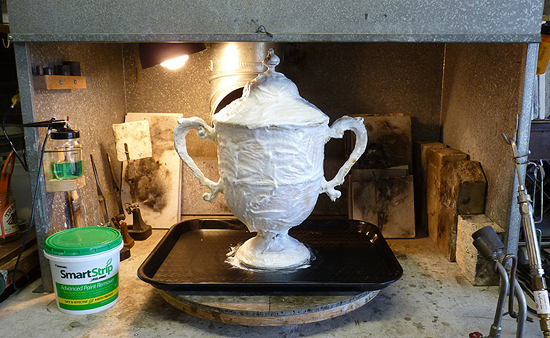
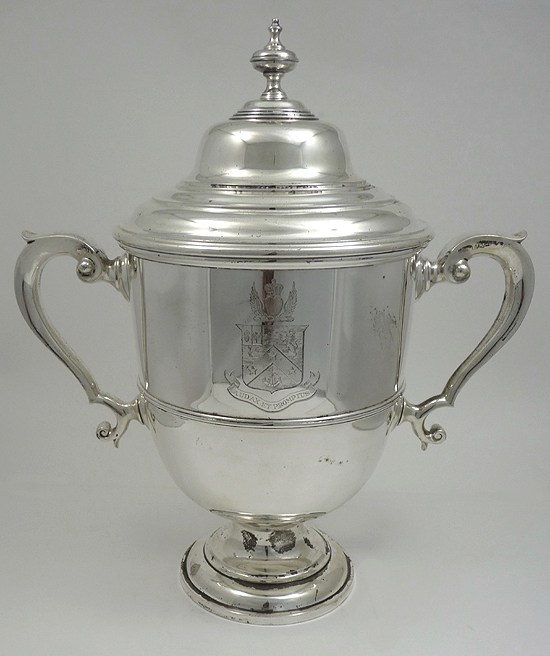 This image shows the cleaned trophy with the surface not yet polished. Two major dents were removed and the interior surfaces (which contained no lacquer) were cleaned and hand polished. The resulting surface required light machine polishing to remove all tarnish and micro-etching caused by the tarnish.
This image shows the cleaned trophy with the surface not yet polished. Two major dents were removed and the interior surfaces (which contained no lacquer) were cleaned and hand polished. The resulting surface required light machine polishing to remove all tarnish and micro-etching caused by the tarnish.
Below is the trophy with its final finish. The age of the piece is still evident with its patina of minute scratches and “dimples.” This is a better outcome than what often emerges from a mass-finishing service which may overpolish silver, removing this valuable patina and possibly damaging the crisp engraving.
Mr. Herman is the owner of Jeffrey Herman Silver Restoration & Conservation located in West Warwick, RI. He can be contacted via email jeff@hermansilver.com or by phone 1-800-339-0417. Or visit his website at www.hermansilver.com
Please subscribe
at the top right of this page
to continue to receive these newsletters.
Follow us on Facebook and Twitter
The Institute is dedicated to raising service standards by broadly disseminating the mindset and skills of that time-honored, quintessential service provider, the British Butler, adapted to the needs of modern employers and guests in staffed homes, luxury hotels, resort, spas, retirement communities, jets, yachts, & cruise ships around the world.




